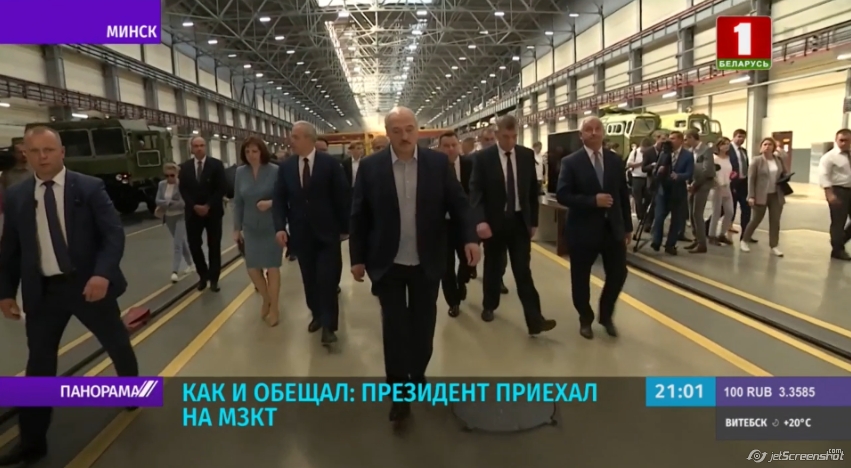
President Alyaksandr Lukashenka visiting a tractor factory on August 17. Screenshot: Belarusian TV 1 news.
EUvsDisinfo had a look at state-controlled media in Belarus to see how Belarusian media is covering the events unravelling in their country. State-controlled media spreads a mix of disinformation, threats and glorification to convince audiences that President Alyaksandr Lukashenka is the guarantor of economic stability and order while the opposition and the West will bring only chaos.
The main platforms used by Belarusian authorities to convey their narratives are the evening news broadcasts on state-controlled TV stations such as Belarus 1, ONT, STV and Mir TV. As the narratives below suggest (in addition to passing the opposition protests under silence and extensively covering Lukashenka’s activities), the informational function of state-controlled media is sometimes replaced by the transmission of official ideological messages.
It should be noted that the level of coordination across TV 1, ONT and STV, for instance, was rather high, illustrated by the fact that news stories had similar structures and that positions often overlapped. There was, however no content sympathetic to the demands of the protesters. There were also a number of news stories that levelled accusations and threats against protesters.
Below is a short selection of examples describing what was shown to viewers on Belarusian state-controlled TV channels.
- The president spoke frankly with workers at a tractor factory. (TV 1, 17 Aug; the report lasted 18 minutes)
- A state-organised rally expressed support for Lukashenka, it was spontaneous, organised in half-a-day without the help of social media. (TV 1, 17 Aug; the report lasted 21 minutes)
- Thousands of people who are tired of protests and want to keep the country peaceful and independent gathered for a pro-government rally. (TV 1, 18 Aug)
- There were some opposition protests and they could bring chaos (TV 1, 17 Aug; section lasted for 31 seconds)
- Strikers are responsible for losses to enterprises and they will be held accountable (STV, 18 Aug)
In addition to news, advertisements depicting a bleak future for Belarus in the event of a change of power were regularly broadcasted:
The narratives on state TV were largely echoed by the presidential news agency BelTA (also in English) and by state-run newspapers and news sites such as Belarus Segodnia, Respublika, Narodnaya Hazeta and Zvyazda.
- The Oppositions programme is dangerous for the country, causing chaos, strikes and threats to civil servants (Belarus Segodnia, 18 Aug)
- Border protection should be strengthened; the opposition is financed from abroad, and the KGB should continue uncovering financing channels. (BelTA and state-owned TV channels, 19 Aug).
- The MFA should warn Merkel, Macron, Duda, Nauseda about liability for inflaming unrest in Belarus. (BelTA and state-owned TV channels, 19 Aug).
- The creation of the Coordinating Council by the opposition is a coup attempt (BelTA, 18 Aug)
- There is a threat from the West, therefore military units have been deployed on the western border (BelTA, 18 Aug)
Some local pro-Kremlin disinformation sites also seem to promote a pro-Russian course. Sonar2050, for instance, was listed by the Estonian Foreign Intelligence Service in its yearbook as one of numerous Russian platforms promoting the idea of unity between Russia and Belarus.
- Traitors and anti-Russian figures have to be removed so that Russia can become the moderator of the political crisis; Polish and Lithuanian control of the media sphere has to be stopped (Sonar2050, 18 Aug).
- The guarantee of the country’s sovereignty and independence is unconditional preservation and development of the Union with Russia and SCTO. (Vmeste s Rossiyey, 18 Aug)
- Pro-Russian forces in Belarus should advocate a parliamentary republic to ensure that all state officials are pro-Russian, to immediately legitimise all pro-Russian organisations in Belarus, to adopt the Constitutional Act of the Union State (Teleskop, Vitbich, Grodnodaily, 17-18 Aug).
- Belarusians are an integral part of Russian civilisation, to resolve the political crisis the state authorities should start a wide dialogue with civil initiatives which represent the majority of society, i.e. the pro-Russian movements (Sozh, 18 Aug)
As the list of outlets and narratives show, the Belarusian opposition has to find alternative channels to convey its messages. In addition to independent news sites like Charter 97, naviny.by, euroradio and reform.by there are also bloggers and Telegram channels.
One of these is the Telegram channel Nexta, which is run by a team of 6 people and which currently has 2.1 million followers. It mostly shares images and videos of the protests, revealing how authorities are trying to stop the political action or strikes by intimidation. The channel also brings news from the field, informing how local authorities allow protest outside the capital and release detained protestors (see here NEXTA Live on Telegram).
Considering the government’s tight control over state media in Belarus and widening gap between events in the real world and the way they are portrayed on TV, journalists started resigning and protests began to demand more independence for media. According to independent media, Russian journalists have been brought in to fill the vacant positions left following the resignations in Belarusian state-run media houses. This would probably mean that censorship and the current editorial line will continue to be entrenched on Belarusian state media.




